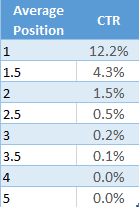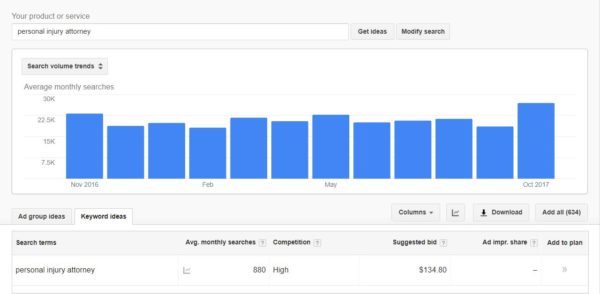The Top 5 AdWords Mistakes Lawyers Make
by Jeff Allan • November 29, 2017
If there’s one thing I’ve learned working with law firms, it’s that successfully advertising your firm on AdWords is tough. It’s extremely competitive and—when you’re paying over $50 a click—you can’t afford to make mistakes. Unfortunately, that doesn’t stop most law firms from making one or more of the following 5 mistakes:
- Focusing on Being #1
- Poor Geographic Targeting
- Ineffective Intent-Ad-Landing Page Matching
- Only Using Exact Match
- Failing to Use Location Extensions
The good news is, these legal advertising mistakes are fairly easy to fix. You might be wasting money on them now, but that doesn’t mean you have to keep wasting money on them. In this article, we’re going to take a look at each of these mistakes and how to solve them.
1. Focusing on Being #1
Yes, I know that we’re talking about lawyers here. Second place is first loser. You don’t get through law school, pass the bar exam and win cases with a “second place is good enough” sort of attitude.
However, when it comes to AdWords, sometimes ranking #1 on for a keyword means you’re losing…losing money. In the highly competitive legal industry, everyone wants to rank #1.
Yes, you get the best clickthrough rates at position #1 (see the chart below), but if your ads aren’t profitable at position #1, all of those extra clicks just mean extra wasted money. 
In contrast, an average rank of 1.5 might produce 1/3rd of the clicks, but those clicks usually cost a lot less. As a result, the ads are usually more profitable, so in this situation, targeting rank 1.5 decreases clicks…and increases profit.
That’s a win in my book.
Another reason why focusing on being #1 isn’t always the key to AdWords success is the fact that most potential clients click ad #1 as part of their “lawyer shopping” research. But, since picking a lawyer is a big choice, most people want to check out a few other options before they commit.
As a result, if you’re in position #1, your lead quality tends to be lower and you end up spending a lot more money on window shopper clicks and low quality leads. In contrast, if you target position #2-2.5, you usually end up with more informed, higher quality leads—and at a lower cost, too!
Fixing Things
In general, I find that most of my clients get their best results when their ads have an average position between 1.5 and 2.5. As long as they’re getting at least 30 clicks per day, this sort of position allows me to see which ad copy and landing pages are performing well while maximizing the client’s return-on-investment.
2. Poor Geographic Targeting
Another major problem I frequently see in legal advertising campaigns is ineffective geographic targeting. On the surface, the reasons for this are immediately obvious. For example, if you serve clients all over the state of New York, it seems like targeting the state of New York with your ads would be a great idea.
However, even if you serve all of New York, I’d be willing to bet good money that your ads do not perform equally well across the entire state.
Odds are, in some parts of the state, certain keywords and ads are incredibly profitable. In others, you’re probably losing money. But, if you’re targeting the whole state of New York, AdWords won’t tell you where your ads are profitable and where you need to rethink your strategy.
Fixing Things
To solve this problem, you need to create campaigns that target specific local areas. This will allow you to set your budgets and bids based on ad performance.
In addition, you can use this strategy to give your ads a much stronger local feel. Since your campaigns are location-specific, you can use local phone numbers and even create landing pages with locally relevant content. That way, it feels like your firm is right next door.
3. Ineffective Intent-Ad-Landing Page Matching
Along the same lines, many law firms do a poor job of creating ads and landing pages that match the intent of their audience. For example, if someone searches for a personal injury lawyer, clicks on an ad for a personal injury lawyer and ends up on the following landing page, what are the odds that they’re going to convert?

No matter how good Weyher Fulkerson is at personal injury law, a potential personal injury client who finds themselves on this page is going to be hitting the back button, fast.
The same idea applies to ads. If someone from the Bay Area searches “personal injury lawyer”, which of the following headlines are they more likely to click on?
- “Best Personal Injury Law Firm in LA”
- “Let LA’s Top Legal Experts Help You”?
Sure, “LA’s Top Legal Experts” might be great at personal injury law, but the searcher is looking for help with their personal injury case, so they’ll probably click on the ad that talks about personal injury law.
Moral of the story? If your ads and landing pages don’t match the intent of a searcher, you can expect to pay more for lower quality clicks and fewer conversions.
Fixing Things
To solve this problem, take those local campaigns we talked about and create ad groups that target single keyword ad groups (SKAGs). Essentially, a single keyword ad group is a group of ads that target the same basic keyword.
For example, if you are running ads for a law firm in LA that handles personal injury cases, you might create an ad group within your LA campaign that targets the keywords [personal injury law] (exact match), “personal injury law” (phase match) and +personal +injury +law (broad match modified).
Yes, it’s only one keyword, but by targeting these multiple match types, you could rank for any of the following searches (and a lot of other similar variations):
- “personal injury law”
- “personal injury law firm”
- “personal injury lawyer”
- “la personal injury law firm”
- “personal injury law firm near me”
- “best personal injury law firm in los angeles”
While these searches are all different, they all have the same basic intent: “I need a personal injury law firm.” If the headline of your ad reads “Best Personal Injury Law Firm in LA”, there’s a very good chance that anyone who sees your ad will be likely to click on it. If your landing page is focused on your firm’s track record in personal injury law, well, a lot of those clicks will probably turn into leads, too.
Using this approach, my clients typically see better click-through rates, lower costs-per-click and higher conversion rates. That’s a win for everyone.
4. Only Using Exact Match
Now, you’re probably thinking, “Wait, you just told me to use exact match in the last section. Why are you telling me that targeting exact match is a common problem?”
On the surface, exact match might seem like a great way to go. Using our previous example, “personal injury attorney” looks like a great exact match keyword for an LA-based firm. It has good search volume and great intent.

The only problem is, you’re not the only one who knows that “personal injury attorney” is a great keyword. Look at the competition for this keyword! The stiffer the competition, the more expensive the clicks and the harder it is to make a profit.
Fixing Things
The solution, of course, is to use SKAGs. The level of intent for “injury law firm” is probably about the same as for “personal injury attorney”, but in Los Angeles, the cost-per-click for “injury law firm” is roughly 1/6th the cost-per-click for “personal injury attorney.”
Yes, the search volume is also a lot lower, but with SKAGs, your ads will show up for a range of high intent search terms with much better costs-per-click than you could ever get on an exact match keyword.
5. Not Using Location Extensions
The last mistake primarily applies to firms with multiple offices. Location extensions add your address to your ad, like so:

It might not seem like a big deal, but location extensions increase the size of your ad and can help give your firm a more local feel.
As you’ve probably noticed throughout this post, location is a big deal to many potential clients, so the more you can do to increase the local feel of your ads (local phone numbers, location-specific landing pages, location extensions, etc), the better they will perform.
Fixing Things
The good news is, setting up location extensions is quite easy. All you need to do is set your location up on Google My Business. After adding in a location, you can verify the location via phone call or post card. Once your business is verified, you can add the location extensions in AdWords.
Easy enough, right? In fact, it’s so easy that I recommend adding as many locations as possible. In some cases, it might even be worth renting out a space you use for distant clients so that you can have a local presence for your ads.
Conclusion
If you’re like most law firms, there’s a good chance that you’re struggling with one or more of these common mistakes. The good news is, though, that all of these mistakes are surmountable. So, with a little effort, you should be able to significantly improve the performance of your AdWords campaigns.
By the way, if you’d like me to take a look at your law firm’s AdWords campaigns and give you feedback, let me know here or in the comments.
What are some of the major mistakes you see law firms making on AdWords? Any other advice you’d like to add?





